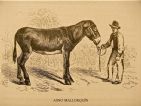
Donkeys and mules
 "According to statistics from 1868, the number of donkey owners reached 11,454; of these, 4,999 were in the district of Manacor, 3,611 in Inca and 2,844 in Palma. Bearing in mind the total number of animals, the respective averages are per owner: 1.5 on the entire island, while, per district, 1.23 in Manacor, 1.19 in Inca and 1.35 in Palma. This is due to the fact that many owners, if not the majority, only have one animal, while those who have more, have a maximum of 4 or 5. However, the largest herd has 25 animals.
"According to statistics from 1868, the number of donkey owners reached 11,454; of these, 4,999 were in the district of Manacor, 3,611 in Inca and 2,844 in Palma. Bearing in mind the total number of animals, the respective averages are per owner: 1.5 on the entire island, while, per district, 1.23 in Manacor, 1.19 in Inca and 1.35 in Palma. This is due to the fact that many owners, if not the majority, only have one animal, while those who have more, have a maximum of 4 or 5. However, the largest herd has 25 animals.
Donkeys normally feed on the grasses in the field, especially in the mountainous parts where reeds (càrritx) are generously abundant. In stables, they’re fed with some hay, while those working the fields are also given barley and some carob.
There is only one known breed of donkeys on Mallorca, considered to be autochthonous though its origin is unknown. However, there are two varieties, one serving for farm chores, to transport dung, water, fruit and other products from the field, as well as to transport farmhands and people of more modest means, especially women. The other variety is larger and with a rougher frame, used also for farm chores but also to breed mules. Both varieties are abundant on the island, though the first is more frequent in mountain districts where it stands out for the beauty of its form, its great agility and more determined and tenacious disposition. The second variety abounds primarily in the districts of Manacor, Felanitx, Artà, Llucmajor, Santanyí and in other places on the plain.
Much more numerous than donkeys and horses to ride, pull and work are the island’s mules. The preference for these is perfectly justified since, though more difficult to train, they are long-lived, cheaper in terms of food and much more resistant to any effort. Some 10 or 12 years ago they were even much more common, and people in the city didn’t even think of buying horses. Today, in contrast, the greater presence of the latter seems to be the reason that the number of mules hasn’t increased.
The number of mule owners is between 10,000 or 12,000, since the majority of farmers and small land owners have only one animal, generally male, which serves them to both work the fields and pull the cart. The so-called possessions, in contrast, have, without fail, one, two, three or even more pairs of mules depending on the size and importance of these estates. Thus, to determine the number of these animals, we have to estimate the size of the estate. That explains why they talk about estates with one pair, possessió d’una parella, two pairs, de dues parelles, three pairs of mules, and so on."
Archduke Ludwig Salvator of Austria. Las Baleares por la palabra y el grabado. Majorca: General Part. Ed. Sa Nostra, Caja de Baleares. Palma de Mallorca. 1982.






















